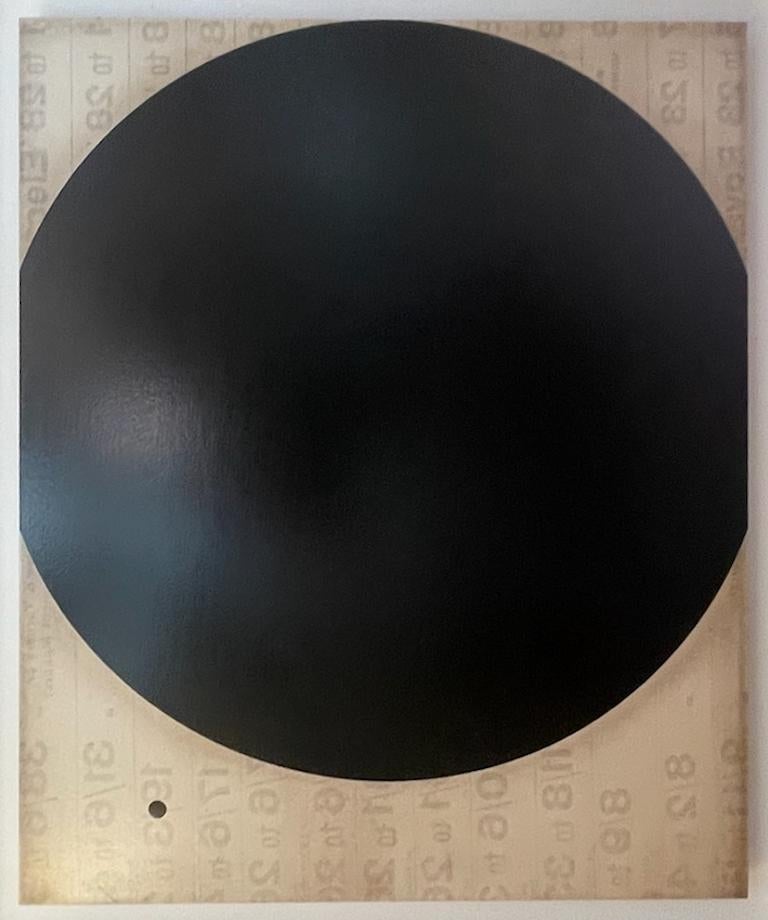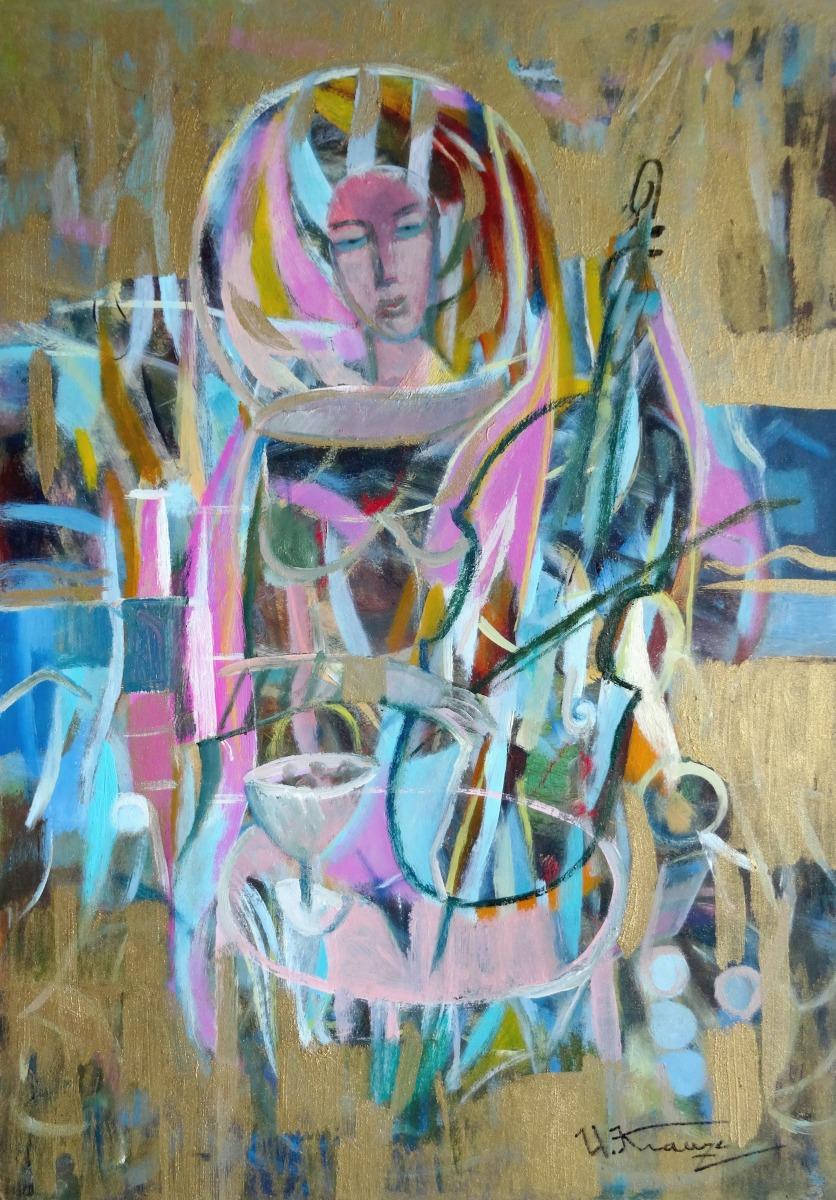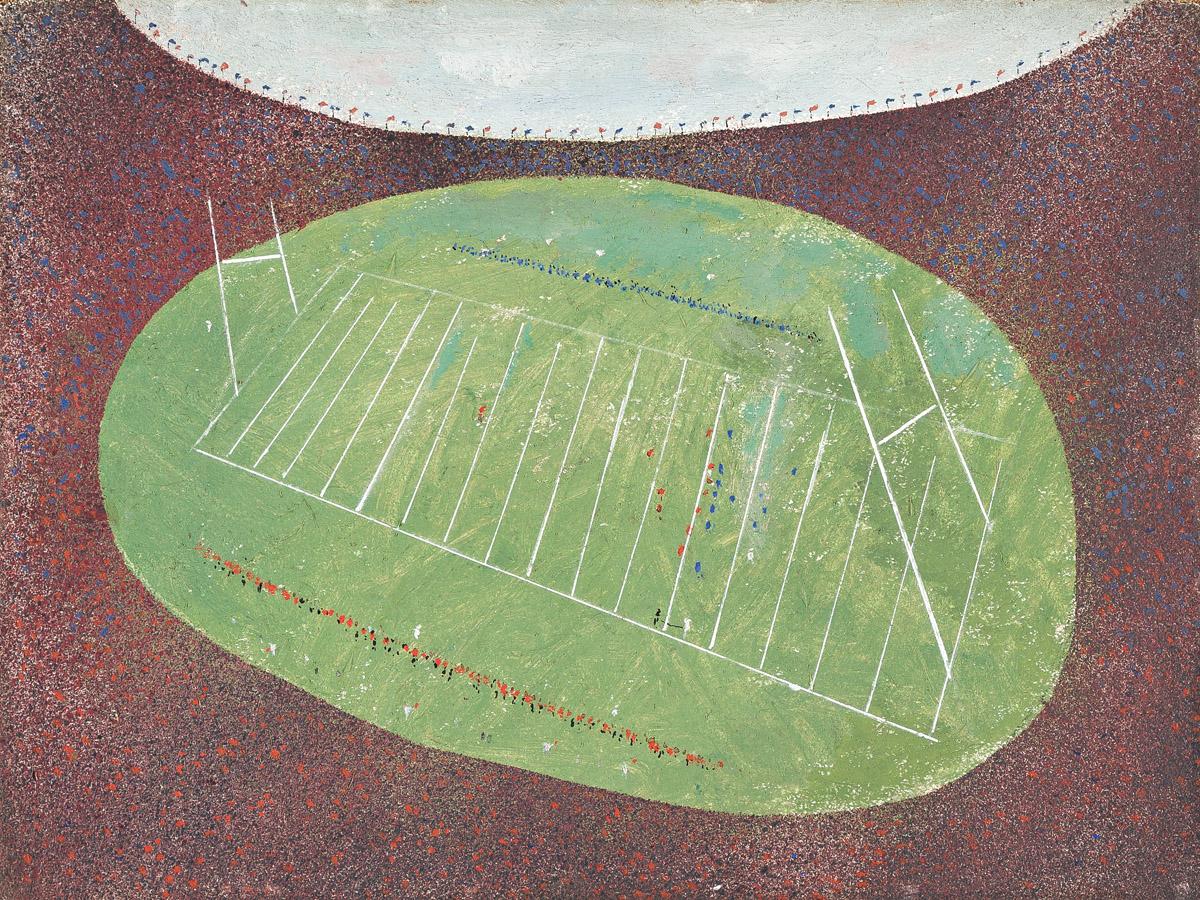Items Similar to 1950s Abstract Oil Painting, Blue, Pink, Yellow, Black, Vertical Horizontal
Video Loading
Want more images or videos?
Request additional images or videos from the seller
1 of 16
Paul Kauvar Smith1950s Abstract Oil Painting, Blue, Pink, Yellow, Black, Vertical Horizontalcirca 1955
circa 1955
About the Item
Abstract painting in blue, pink, yellow, green, and black by Paul Kauvar Smith (1893-1977). Oil on board. Presented in a custom frame, outer dimensions measure 29 ½ x 23 ¾ x 2 inches. Image size is 24 x 18 inches. Painting has been framed to be able to be hung either horizontally or vertically.
Painting is clean and in very good vintage condition - please contact us for a detailed condition report.
Provenance: Estate of the artist, Paul K. Smith
Expedited and international shipping is available - please contact us for a quote.
About the Artist:
Paul Kauver Smith studied commercial art and design at the St. Louis School of Fine Arts from 1915-16 with a brief interruption during World War I. After the war, he returned to the School of Fine Arts and went on to study at Washington University in St. Louis.
In 1921, Smith moved to Colorado to study under John E. Thompson at the Denver Academy of Fine and Applied Arts. Thompson, who is considered to be the pioneer of modernism in Denver, was a strong influence on Smith.
In 1923, Smith was hired by the Academy as an instructor. That same year, his work was accepted for the first time for display at the Denver Art Museum and he was also awarded two solo exhibitions. The museum later added his work to their Anne Evans collection. In 1959, the Denver Art Museum also reproduced one of his paintings titled Houses at Victor for their Western Heritage exhibition catalogue.
Smith became a permanent resident of Denver and was a member of the American Artists Professional League as well as the Colorado and the Denver Art Guilds. He also joined a Denver group called The Colorado Fifteen. “The Fifteen” came into existence in 1948 as an association of professional artists dedicated to the avant-garde. The group was well known and was a crucial contribution to Denver's cultural landscape.
- Creator:Paul Kauvar Smith (1893 - 1977, American)
- Creation Year:circa 1955
- Dimensions:Height: 29.5 in (74.93 cm)Width: 23.75 in (60.33 cm)Depth: 2 in (5.08 cm)
- Medium:
- Movement & Style:
- Period:
- Condition:
- Gallery Location:Denver, CO
- Reference Number:
About the Seller
5.0
Platinum Seller
These expertly vetted sellers are 1stDibs' most experienced sellers and are rated highest by our customers.
Established in 1979
1stDibs seller since 2013
265 sales on 1stDibs
Typical response time: 3 hours
- ShippingRetrieving quote...Ships From: Denver, CO
- Return PolicyA return for this item may be initiated within 7 days of delivery.
More From This SellerView All
- Light of Hope, 1970s Abstract Geometric Oil Painting Red Black and BrownLocated in Denver, CO1970s abstract oil on canvas by Broadmoor Academy artist Lawrence (Larry) Harris (1937-2008). Geometric shapes across the center of the canvas in warm colors of red, orange, yellow, black and brown. Presented in a custom wood frame measuring 20 ½ x 26 ½ inches. Image size measures 18 x 24 inches. Piece is clean and in very good condition - please contact us for a detailed condition report. Expedited and international shipping is available - please contact us for a quote. About the Artist: Lawrence Harris...Category
1970s Abstract Geometric Abstract Paintings
MaterialsCanvas, Oil
- Basic Form Problem #2, 1940s Framed Blue, Green Abstract Geometric Oil PaintingBy Ralph AndersonLocated in Denver, COGeometric shape abstract painting in green, blue, and orange. Oil on paper. Presented in a custom hardwood frame with all archival ...Category
Mid-20th Century Abstract Geometric Abstract Paintings
MaterialsOil
- The Warrior and the Star Precedes the Sun (Hopi Ceremony, Oraibe, Arizona)By Charles Stewart, 1922-2011Located in Denver, CO20th Century Southwestern Native American oil painting Hopi Ceremony in Oraibe, Arizona by New Mexico artist, Charles C. Stewart (1922-201...Category
Mid-20th Century Abstract Geometric Abstract Paintings
MaterialsCanvas, Oil
- Summer Holiday, Abstract Geometric Acrylic and Canvas Collage, Red White BlueBy Margo HoffLocated in Denver, COAcrylic and canvas collage on canvas by 20th century artist Margo Hoff (1910-2008). An abstract geometric painting in Margo's signature style of canvas collage, laying bits of canva...Category
20th Century Abstract Geometric Abstract Paintings
MaterialsCanvas, Acrylic
- Light Street, Geometric Abstract Collage of a Street Lamps at NightBy Margo HoffLocated in Denver, COCanvas collage, acrylic and crayon on canvas by 20th Century artist Margo Hoff (1910-2008) titled 'Lighted Street' depicting and abstract image of a street at night with glowing stre...Category
1980s Abstract Geometric Mixed Media
MaterialsCanvas, Crayon, Acrylic
- New York City Abstract Skyline, Semi Abstract Night Scene Cityscape Oil PaintingBy Charles Ragland BunnellLocated in Denver, COOil on board painting of abstracted New York City skyline by Charles Ragland Bunnell from 1951. Nocturne cityscape painted in colors of black, shades of blue, and yellow. Presented in a custom black frame, outer dimensions measure 30 ¼ x 12 ¼ x ¾ inches. Image size is 30 x 12 ¼ inches. Painting is in good vintage condition - please contact us for detailed condition report. Provenance: Estate of Charles Ragland Bunnell Expedited and international shipping is available - please contact us for a quote. About the Artist: Charles Bunnell developed a love for art at a very young age. As a child in Kansas City, Missouri, he spent much of his time drawing. When he was unable to find paper he drew on walls and in the margins of textbooks for which he was often fined. Around 1915, Bunnell moved with his family to Colorado Springs, Colorado. He served in World War I and later used his GI Training to study at the Broadmoor Art Academy (later renamed the Colorado Springs Fine Arts Center) during 1922 and 1923. In 1922, he married fellow student, Laura Palmer...Category
1950s Abstract Abstract Paintings
MaterialsOil, Board
You May Also Like
- "Still Life of Fruits", 20th Century Oil on Cardboard by Artist Francisco BoresBy Francisco BoresLocated in Madrid, ESFRANCISCO BORES Spanish, 1898 - 1972 STILL LIFE OF FRUITS signed "Borès 45´" (lower right) oil on cardboard 15-3/4 x 19-3/4 (40 x 50 cm.) framed: 18-1/4 x 22-1/8 inches (46 x 56 cm.) PROVENANCE Private French Collector Francisco Bores López (Madrid, May 5, 1898 - Paris, May 10, 1972) was a Spanish painter of the so-called New School of Paris. His artistic training originated both in the Cecilio Pla painting academy, where he met Pancho Cossío, Manuel Ángeles Ortiz or Joaquín Peinado...Category
1940s Abstract Geometric Still-life Paintings
MaterialsOil, Cardboard
- Mimesis NoirBy Robert KellyLocated in New York, NY2012 Oil and mixed media on board 17 x 14 in. (43.2 x 35.6 cm) Signed and dated, verso FramedCategory
2010s Abstract Geometric Abstract Paintings
MaterialsMixed Media, Oil, Board
- Solo II 2005., Cardboard, author's technique, 64x45 cmLocated in Riga, LVSolo II Uldis Krauze (1958) 2005., Cardboard, author's technique, 64x45 cmCategory
Early 2000s Abstract Geometric Figurative Paintings
MaterialsOil, Cardboard
- Large Geometric Abstract Titled AfricanaLocated in Delray Beach, FLAfricana Mid-Century Modern large and impressive mixed media stone, sand and oil on artist board. The painting is unsigned there is a small fragment of old paper label with number #2...Category
1960s Abstract Geometric Abstract Paintings
MaterialsSandstone
- "Harvard vs Yale" Charles Green Shaw, Football, Ivy League Sports, AbstractBy Charles Green ShawLocated in New York, NYCharles Green Shaw Harvard vs. Yale, 1944 Signed and dated on the reverse Oil on canvasboard 9 x 12 inches Provenance: Harvey and Francois Rambach, New Jersey Private Collection, California Washburn Gallery, New York D. Wigmore Fine Art, New York Private Collection, New York Charles Green Shaw, born into a wealthy New York family, began painting when he was in his mid-thirties. A 1914 graduate of Yale, Shaw also completed a year of architectural studies at Columbia University. During the 1920s Shaw enjoyed a successful career as a freelance writer for The New Yorker, Smart Set and Vanity Fair, chronicling the life of the theater and café society. In addition to penning insightful articles, Shaw was a poet, novelist and journalist. In 1927 he began to take a serious interest in art and attended Thomas Hart Benton's class at the Art Students League briefly in New York. He also studied privately with George Luks, who became a good friend. Once he had dedicated himself to non-traditional painting, Shaw's writing ability made him a potent defender of abstract art. After initial study with Benton and Luks, Shaw continued his artistic education in Paris by visiting numerous museums and galleries. From 1930 to 1932 Shaw's paintings evolved from a style imitative of Cubism to one directly inspired by it, though simplified and more purely geometric. Returning to the United States in 1933, Shaw began a series of abstracted cityscapes of skyscrapers he called Manhattan Motifs which evolved into his most famous works, the shaped canvases he called Plastic Polygons. The 1930s were productive years for Shaw. He showed his paintings in numerous group exhibitions, both in New York and abroad, and was also given several one-man exhibitions. Shaw had his first one-man exhibition at the Valentine Dudensing Gallery in New York in 1934, which included 25 Manhattan Motif paintings and 8 abstract works. In the spring of 1935 Shaw was introduced to Albert Gallatin and George L.K. Morris. Gallatin was so impressed with Shaw's work, he broke a policy against solo exhibitions at his museum, the Gallery of Living Art, and offered Shaw an exhibition there. In the summer of 1935 Shaw traveled to Paris with Gallatin and Morris who provided introductions to many great painters. Shaw regularly spent time with John Ferren and Jean Hélion. The following year Gallatin organized an exhibition called Five Contemporary American Concretionists at the Reinhardt Gallery that included Shaw, Ferren, and Morris, Alexander Calder, and Charles Biederman...Category
1940s Abstract Geometric Landscape Paintings
MaterialsOil, Board
- "Untitled, " Seymour Fogel, Geometric Abstraction, Texas Hard-EdgeBy Seymour FogelLocated in New York, NYSeymour Fogel Untitled Oil on illustration board construction 10 x 7 1/2 inches Provenance: Estate of the artist Charles and Faith McCracken Larry and Trish Heichel Private Collection Seymour Fogel was born in New York City on August 24, 1911. He studied at the Art Students League and at the National Academy of Design under George Bridgeman and Leon Kroll. When his formal studies were concluded in the early 1930s he served as an assistant to Diego Rivera who was then at work on his controversial Rockefeller Center mural. It was from Rivera that he learned the art of mural painting. Fogel was awarded several mural commissions during the 1930s by both the Works Progress Administration (WPA) and the Treasury Section of Fine Arts, among them his earliest murals at the Abraham Lincoln High School in Brooklyn, New York in 1936, a mural in the WPA Building at the 1939-1940 New York World's Fair, a highly controversial mural at the U.S. Post Office in Safford, Arizona (due to his focus on Apache culture) in 1941 and two murals in what was then the Social Security Building in Washington, D.C., also in 1941. Fogel's artistic circle at this time included Phillip Guston, Ben Shahn, Franz Kline, Rockwell Kent and Willem de Kooning. In 1946 Fogel accepted a teaching position at the University of Texas at Austin and became one of the founding artists of the Texas Modernist Movement. At this time he began to devote himself solely to abstract, non-representational art and executed what many consider to be the very first abstract mural in the State of Texas at the American National Bank in Austin in 1953. He pioneered the use of Ethyl Silicate as a mural medium. Other murals and public works of art done during this time (the late 1940s and 1950s) include the Baptist Student Center at the University of Texas (1949), the Petroleum Club in Houston (1951) and the First Christian Church, also in Houston (1956), whose innovative use of stained glass panels incorporated into the mural won Fogel a Silver Medal from the Architectural League of New York in 1958. Fogel relocated to the Connecticut-New York area in 1959. He continued the Abstract Expressionism he had begun exploring in Texas, and began experimenting with various texturing media for his paintings, the most enduring of which was sand. In 1966 he was awarded a mural at the U.S. Federal Building in Fort Worth, Texas. The work, entitled "The Challenge of Space", was a milestone in his artistic career and ushered in what has been termed the Transcendental/Atavistic period of his art, a style he pursued up to his death in 1984. Painted and raw wood sculpture...Category
Mid-20th Century Abstract Geometric Abstract Paintings
MaterialsOil, Board
Recently Viewed
View AllMore Ways To Browse
Yellow Black
Blue Pink
Pink Yellow
Vintage Vertical
Blue Black 1950s
Blue Vintage Painting
Yellow Black 1950s
World War 2 Paintings
Vintage Commercials 1950S
Vintage Geometric Abstract Art
John E Paintings
Vintage Oil Painting Blue
Circa 1915 Paintings
16 X 24 Abstract
John Denver
Green Vintage Oil Paintings
John Smith Vintage
Paul Evans Art




